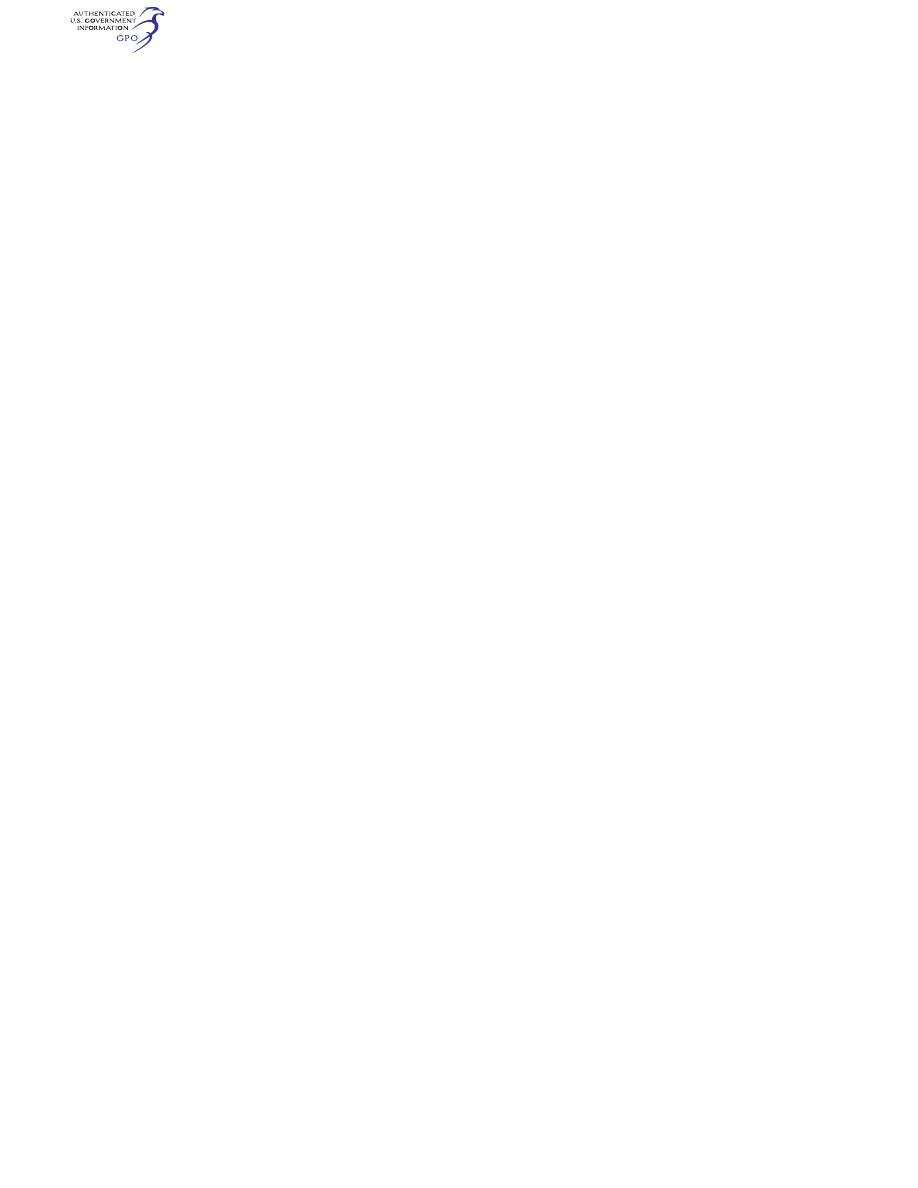
395
Transportation Security Administration, DHS
§ 1552.1
operations, public charter passenger
operations, and private charter pas-
senger operations, that are in accord-
ance with a security program issued
under part 1544 or 1546 of this chapter.
(b)
Procedures. Any person conducting
an operation identified in paragraph (a)
of this section must conduct a search
of the aircraft before departure and
must screen passengers, crewmembers,
and other individuals and their acces-
sible property (carry-on items) before
boarding in accordance with security
procedures approved by TSA.
(c)
Sensitive security information. The
security program procedures approved
by TSA for operations specified in
paragraph (a) of this section are sen-
sitive security information. The oper-
ator must restrict the distribution, dis-
closure, and availability of information
contained in the security procedures to
persons with a need to know as de-
scribed in part 1520 of this chapter.
(d)
Compliance date. Persons con-
ducting operations identified in para-
graph (a) of this section must imple-
ment security procedures on October 6,
2001.
(e)
Waivers. TSA may permit a person
conducting an operation under this sec-
tion to deviate from the provisions of
this section if TSA finds that the oper-
ation can be conducted safely under
the terms of the waiver.
§ 1550.7
Operations in aircraft of
12,500 pounds or more.
(a)
Applicability of this section. This
section applies to each aircraft oper-
ation conducted in an aircraft with a
maximum certificated takeoff weight
of 12,500 pounds or more except for
those operations specified in § 1550.5
and those operations conducted under a
security program under part 1544 or
1546 of this chapter.
(b)
Procedures. Any person conducting
an operation identified in paragraph (a)
of this section must conduct a search
of the aircraft before departure and
screen passengers, crewmembers, and
other persons and their accessible prop-
erty (carry-on items) before boarding
in accordance with security procedures
approved by TSA.
(c)
Compliance date. Persons identi-
fied in paragraph (a) of this section
must implement security procedures
when notified by TSA. TSA will notify
operators by NOTAM, letter, or other
communication when they must imple-
ment security procedures.
(d)
Waivers. TSA may permit a person
conducting an operation identified in
this section to deviate from the provi-
sions of this section if TSA finds that
the operation can be conducted safely
under the terms of the waiver.
PART 1552—FLIGHT SCHOOLS
Subpart A—Flight Training for Aliens and
Other Designated Individuals
Sec.
1552.1
Scope and definitions.
1552.3
Flight training.
1552.5
Fees.
Subpart B—Flight School Security
Awareness Training
1552.21
Scope and definitions.
1552.23
Security awareness training pro-
grams.
1552.25
Documentation, recordkeeping, and
inspection.
A
UTHORITY
: 49 U.S.C. 114, 44939.
S
OURCE
: 69 FR 56340, Sept. 20, 2004, unless
otherwise noted.
Subpart A—Flight Training for
Aliens and Other Designated
Individuals
§ 1552.1
Scope and definitions.
(a)
Scope. This subpart applies to
flight schools that provide instruction
under 49 U.S.C. Subtitle VII, Part A, in
the operation of aircraft or aircraft
simulators, and individuals who apply
to obtain such instruction or who re-
ceive such instruction.
(b)
Definitions. As used in this part:
Aircraft simulator means a flight sim-
ulator or flight training device, as
those terms are defined at 14 CFR 61.1.
Alien means any person not a citizen
or national of the United States.
Candidate means an alien or other in-
dividual designated by TSA who ap-
plies for flight training or recurrent
training. It does not include an indi-
vidual endorsed by the Department of
Defense for flight training.
Day means a day from Monday
through Friday, including State and
VerDate Sep<11>2014
13:18 Nov 27, 2023
Jkt 259235
PO 00000
Frm 00405
Fmt 8010
Sfmt 8010
Y:\SGML\259235.XXX
259235
skersey on DSK4WB1RN3PROD with CFR

396
49 CFR Ch. XII (10–1–23 Edition)
§ 1552.3
local holidays but not Federal holi-
days, for any time period less than 11
days specified in this part. For any
time period greater than 11 days, day
means calendar day.
Demonstration flight for marketing pur-
poses means a flight for the purpose of
demonstrating an aircraft’s or aircraft
simulator’s capabilities or characteris-
tics to a potential purchaser, or to an
agent of a potential purchaser, of the
aircraft or simulator, including an ac-
ceptance flight after an aircraft manu-
facturer delivers an aircraft to a pur-
chaser.
Flight school means any pilot school,
flight training center, air carrier flight
training facility, or flight instructor
certificated under 14 CFR part 61, 121,
135, 141, or 142; or any other person or
entity that provides instruction under
49 U.S.C. Subtitle VII, Part A, in the
operation of any aircraft or aircraft
simulator.
Flight training means instruction re-
ceived from a flight school in an air-
craft or aircraft simulator. Flight
training does not include recurrent
training, ground training, a demonstra-
tion flight for marketing purposes, or
any military training provided by the
Department of Defense, the U.S. Coast
Guard, or an entity under contract
with the Department of Defense or U.S.
Coast Guard.
Ground training means classroom or
computer-based instruction in the op-
eration of aircraft, aircraft systems, or
cockpit procedures. Ground training
does not include instruction in an air-
craft simulator.
National of the United States means a
person who, though not a citizen of the
United States, owes permanent alle-
giance to the United States, and in-
cludes a citizen of American Samoa or
Swains Island.
Recurrent training means periodic
training required under 14 CFR part 61,
121,125, 135, or Subpart K of part 91. Re-
current training does not include train-
ing that would enable a candidate who
has a certificate or type rating for a
particular aircraft to receive a certifi-
cate or type rating for another air-
craft.
§ 1552.3
Flight training.
This section describes the procedures
a flight school must follow before pro-
viding flight training.
(a)
Category 1—Regular processing for
flight training on aircraft more than
12,500 pounds. A flight school may not
provide flight training in the operation
of any aircraft having a maximum cer-
tificated takeoff weight of more than
12,500 pounds to a candidate, except for
a candidate who receives expedited
processing under paragraph (b) of this
section, unless—
(1) The flight school has first notified
TSA that the candidate has requested
such flight training.
(2) The candidate has submitted to
TSA, in a form and manner acceptable
to TSA, the following:
(i) The candidate’s full name, includ-
ing any aliases used by the candidate
or variations in the spelling of the can-
didate’s name;
(ii) A unique candidate identification
number created by TSA;
(iii) A copy of the candidate’s cur-
rent, unexpired passport and visa;
(iv) The candidate’s passport and visa
information, including all current and
previous passports and visas held by
the candidate and all the information
necessary to obtain a passport and
visa;
(v) The candidate’s country of birth,
current country or countries of citizen-
ship, and each previous country of citi-
zenship, if any;
(vi) The candidate’s actual date of
birth or, if the candidate does not
know his or her date of birth, the ap-
proximate date of birth used consist-
ently by the candidate for his or her
passport or visa;
(vii) The candidate’s requested dates
of training and the location of the
training;
(viii) The type of training for which
the candidate is applying, including
the aircraft type rating the candidate
would be eligible to obtain upon com-
pletion of the training;
(ix) The candidate’s current U.S.
pilot certificate, certificate number,
and type rating, if any;
(x) Except as provided in paragraph
(k) of this section, the candidate’s fin-
gerprints, in accordance with para-
graph (f) of this section;
VerDate Sep<11>2014
13:18 Nov 27, 2023
Jkt 259235
PO 00000
Frm 00406
Fmt 8010
Sfmt 8010
Y:\SGML\259235.XXX
259235
skersey on DSK4WB1RN3PROD with CFR

397
Transportation Security Administration, DHS
§ 1552.3
(xi) The candidate’s current address
and phone number and each address for
the 5 years prior to the date of the can-
didate’s application;
(xii) The candidate’s gender; and
(xiii) Any fee required under this
part.
(3) The flight school has submitted to
TSA, in a form and manner acceptable
to TSA, a photograph of the candidate
taken when the candidate arrives at
the flight school for flight training.
(4) TSA has informed the flight
school that the candidate does not pose
a threat to aviation or national secu-
rity, or more than 30 days have elapsed
since TSA received all of the informa-
tion specified in paragraph (a)(2) of this
section.
(5) The flight school begins the can-
didate’s flight training within 180 days
of either event specified in paragraph
(a)(4) of this section.
(b)
Category 2—Expedited processing
for flight training on aircraft more than
12,500 pounds. (1) A flight school may
not provide flight training in the oper-
ation of any aircraft having a max-
imum certificated takeoff weight of
more than 12,500 pounds to a candidate
who meets any of the criteria of para-
graph (b)(2) of this section unless—
(i) The flight school has first notified
TSA that the candidate has requested
such flight training.
(ii) The candidate has submitted to
TSA, in a form and manner acceptable
to TSA:
(A) The information and fee required
under paragraph (a)(2) of this section;
and
(B) The reason the candidate is eligi-
ble for expedited processing under
paragraph (b)(2) of this section and in-
formation that establishes that the
candidate is eligible for expedited proc-
essing.
(iii) The flight school has submitted
to TSA, in a form and manner accept-
able to TSA, a photograph of the can-
didate taken when the candidate ar-
rives at the flight school for flight
training.
(iv) TSA has informed the flight
school that the candidate does not pose
a threat to aviation or national secu-
rity or more than 5 days have elapsed
since TSA received all of the informa-
tion specified in paragraph (a)(2) of this
section.
(v) The flight school begins the can-
didate’s flight training within 180 days
of either event specified in paragraph
(b)(1)(iv) of this section.
(2) A candidate is eligible for expe-
dited processing if he or she—
(i) Holds an airman’s certificate from
a foreign country that is recognized by
the Federal Aviation Administration
or a military agency of the United
States, and that permits the candidate
to operate a multi-engine aircraft that
has a certificated takeoff weight of
more than 12,500 pounds;
(ii) Is employed by a foreign air car-
rier that operates under 14 CFR part
129 and has a security program ap-
proved under 49 CFR part 1546;
(iii) Has unescorted access authority
to a secured area of an airport under 49
U.S.C. 44936(a)(1)(A)(ii), 49 CFR 1542.209,
or 49 CFR 1544.229;
(iv) Is a flightcrew member who has
successfully completed a criminal his-
tory records check in accordance with
49 CFR 1544.230; or
(v) Is part of a class of individuals
that TSA has determined poses a mini-
mal threat to aviation or national se-
curity because of the flight training al-
ready possessed by that class of indi-
viduals.
(c)
Category 3—Flight training on air-
craft 12,500 pounds or less. A flight
school may not provide flight training
in the operation of any aircraft having
a maximum certificated takeoff weight
of 12,500 pounds or less to a candidate
unless—
(1) The flight school has first notified
TSA that the candidate has requested
such flight training.
(2) The candidate has submitted to
TSA, in a form and manner acceptable
to TSA:
(i) The information required under
paragraph (a)(2) of this section; and
(ii) Any other information required
by TSA.
(3) The flight school has submitted to
TSA, in a form and manner acceptable
to TSA, a photograph of the candidate
taken when the candidate arrives at
the flight school for flight training.
(4) The flight school begins the can-
didate’s flight training within 180 days
of the date the candidate submitted the
VerDate Sep<11>2014
13:18 Nov 27, 2023
Jkt 259235
PO 00000
Frm 00407
Fmt 8010
Sfmt 8010
Y:\SGML\259235.XXX
259235
skersey on DSK4WB1RN3PROD with CFR

398
49 CFR Ch. XII (10–1–23 Edition)
§ 1552.3
information required under paragraph
(a)(2) of this section to TSA.
(d)
Category 4—Recurrent training for
all aircraft. Prior to beginning recur-
rent training for a candidate, a flight
school must—
(1) Notify TSA that the candidate has
requested such recurrent training; and
(2) Submit to TSA, in a form and
manner acceptable to TSA:
(i) The candidate’s full name, includ-
ing any aliases used by the candidate
or variations in the spelling of the can-
didate’s name;
(ii) Any unique student identification
number issued to the candidate by the
Department of Justice or TSA;
(iii) A copy of the candidate’s cur-
rent, unexpired passport and visa;
(iv) The candidate’s current U.S.
pilot certificate, certificate number,
and type rating(s);
(v) The type of training for which the
candidate is applying;
(vi) The date of the candidate’s prior
recurrent training, if any, and a copy
of the training form documenting that
recurrent training;
(vii) The candidate’s requested dates
of training; and
(viii) A photograph of the candidate
taken when the candidate arrives at
the flight school for flight training.
(e)
Interruption of flight training. A
flight school must immediately termi-
nate or cancel a candidate’s flight
training if TSA notifies the flight
school at any time that the candidate
poses a threat to aviation or national
security.
(f)
Fingerprints. (1) Fingerprints sub-
mitted in accordance with this subpart
must be collected—
(i) By United States Government per-
sonnel at a United States embassy or
consulate; or
(ii) By another entity approved by
TSA.
(2) A candidate must confirm his or
her identity to the individual or agen-
cy collecting his or her fingerprints
under paragraph (f)(1) of this section by
providing the individual or agency his
or her:
(i) Passport;
(ii) Resident alien card; or
(iii) U.S. driver’s license.
(3) A candidate must pay any fee im-
posed by the agency taking his or her
fingerprints.
(g)
General requirements—(1) False
statements. If a candidate makes a
knowing and willful false statement, or
omits a material fact, when submitting
the information required under this
part, the candidate may be—
(i) Subject to fine or imprisonment
or both under 18 U.S.C. 1001;
(ii) Denied approval for flight train-
ing under this section; and
(iii) Subject to other enforcement ac-
tion, as appropriate.
(2)
Preliminary approval. For purposes
of facilitating a candidate’s visa proc-
ess with the U.S. Department of State,
TSA may inform a flight school and a
candidate that the candidate has re-
ceived preliminary approval for flight
training based on information sub-
mitted by the flight school or the can-
didate under this section. A flight
school may then issue an I–20 form to
the candidate to present with the can-
didate’s visa application. Preliminary
approval does not initiate the waiting
period under paragraph (a)(3) or
(b)(1)(iii) of this section or the period
in which a flight school must initiate a
candidate’s training after receiving
TSA approval under paragraph (a)(4) or
(b)(1)(iv) of this section.
(h)
U.S. citizens and nationals and De-
partment of Defense endorsees. A flight
school must determine whether an in-
dividual is a citizen or national of the
United States, or a Department of De-
fense endorsee, prior to providing flight
training to the individual.
(1)
U.S. citizens and nationals. To es-
tablish U.S. citizenship or nationality
an individual must present to the
flight school his or her:
(i) Valid, unexpired United States
passport;
(ii) Original or government-issued
certified birth certificate of the United
States, American Samoa, or Swains Is-
land, together with a government-
issued picture identification of the in-
dividual;
(iii) Original United States natu-
ralization certificate with raised seal,
or a Certificate of Naturalization
issued by the U.S. Citizenship and Im-
migration Services (USCIS) or the U.S.
VerDate Sep<11>2014
13:18 Nov 27, 2023
Jkt 259235
PO 00000
Frm 00408
Fmt 8010
Sfmt 8010
Y:\SGML\259235.XXX
259235
skersey on DSK4WB1RN3PROD with CFR

399
Transportation Security Administration, DHS
§ 1552.3
Immigration and Naturalization Serv-
ice (INS) (Form N–550 or Form N–570),
together with a government-issued pic-
ture identification of the individual;
(iv) Original certification of birth
abroad with raised seal, U.S. Depart-
ment of State Form FS–545, or U.S. De-
partment of State Form DS–1350, to-
gether with a government-issued pic-
ture identification of the individual;
(v) Original certificate of United
States citizenship with raised seal, a
Certificate of United States Citizenship
issued by the USCIS or INS (Form N–
560 or Form N–561), or a Certificate of
Repatriation issued by the USCIS or
INS (Form N–581), together with a gov-
ernment-issued picture identification
of the individual; or
(vi) In the case of flight training pro-
vided to a Federal employee (including
military personnel) pursuant to a con-
tract between a Federal agency and a
flight school, the agency’s written cer-
tification as to its employee’s United
States citizenship or nationality, to-
gether with the employee’s govern-
ment-issued credentials or other Feder-
ally-issued picture identification.
(2)
Department of Defense endorsees. To
establish that an individual has been
endorsed by the U.S. Department of
Defense for flight training, the indi-
vidual must present to the flight
school a written statement acceptable
to TSA from the U.S. Department of
Defense attache
´
in the individual’s
country of residence together with a
government-issued picture identifica-
tion of the individual.
(i)
Recordkeeping requirements. A
flight school must—
(1) Maintain the following informa-
tion for a minimum of 5 years:
(i) For each candidate:
(A) A copy of the photograph re-
quired under paragraph (a)(3),
(b)(1)(iii), (c)(3), or (d)(2)(viii) of this
section; and
(B) A copy of the approval sent by
TSA confirming the candidate’s eligi-
bility for flight training.
(ii) For a Category 1, Category 2, or
Category 3 candidate, a copy of the in-
formation required under paragraph
(a)(2) of this section, except the infor-
mation in paragraph (a)(2)(x).
(iii) For a Category 4 candidate, a
copy of the information required under
paragraph (d)(2) of this section.
(iv) For an individual who is a United
States citizen or national, a copy of
the information required under para-
graph (h)(1) of this section.
(v) For an individual who has been
endorsed by the U.S. Department of
Defense for flight training, a copy of
the information required under para-
graph (h)(2) of this section.
(vi) A record of all fees paid to TSA
in accordance with this part.
(2) Permit TSA and the Federal Avia-
tion Administration to inspect the
records required by paragraph (i)(1) of
this section during reasonable business
hours.
(j)
Candidates subject to the Depart-
ment of Justice rule. A candidate who
submits a completed Flight Training
Candidate Checks Program form and
fingerprints to the Department of Jus-
tice in accordance with 28 CFR part 105
before September 28, 2004, or a later
date specified by TSA, is processed in
accordance with the requirements of
that part. If TSA specifies a date later
than the compliance dates identified in
this part, individuals and flight schools
who comply with 28 CFR part 105 up to
that date will be considered to be in
compliance with the requirements of
this part.
(k)
Additional or missed flight training.
(1) A Category 1, 2, or 3 candidate who
has been approved for flight training
by TSA may take additional flight
training without submitting finger-
prints as specified in paragraph
(a)(2)(x) of this section if the candidate:
(i) Submits all other information re-
quired in paragraph (a)(2) of this sec-
tion, including the fee; and
(ii) Waits for TSA approval or until
the applicable waiting period expires
before initiating the additional flight
training.
(2) A Category 1, 2, or 3 candidate
who is approved for flight training by
TSA, but does not initiate that flight
training within 180 days, may reapply
for flight training without submitting
fingerprints as specified in paragraph
(a)(2)(x) of this section if the candidate
submits all other information required
in paragraph (a)(2) of this section, in-
cluding the fee.
VerDate Sep<11>2014
13:18 Nov 27, 2023
Jkt 259235
PO 00000
Frm 00409
Fmt 8010
Sfmt 8010
Y:\SGML\259235.XXX
259235
skersey on DSK4WB1RN3PROD with CFR

400
49 CFR Ch. XII (10–1–23 Edition)
§ 1552.5
§ 1552.5
Fees.
(a)
Imposition of fees. The following
fee is required for TSA to conduct a se-
curity threat assessment for a can-
didate for flight training subject to the
requirements of § 1552.3: $130.
(b)
Remittance of fees. (1) A candidate
must remit the fee required under this
subpart to TSA, in a form and manner
acceptable to TSA, each time the can-
didate or the flight school is required
to submit the information required
under § 1552.3 to TSA.
(2) TSA will not issue any fee re-
funds, unless a fee was paid in error.
Subpart B—Flight School Security
Awareness Training
§ 1552.21
Scope and definitions.
(a)
Scope. This subpart applies to
flight schools that provide instruction
under 49 U.S.C. Subtitle VII, Part A, in
the operation of aircraft or aircraft
simulators, and to employees of such
flight schools.
(b)
Definitions: As used in this sub-
part:
Flight school employee means a flight
instructor or ground instructor certifi-
cated under 14 CFR part 61, 141, or 142;
a chief instructor certificated under 14
CFR part 141; a director of training cer-
tificated under 14 CFR part 142; or any
other person employed by a flight
school, including an independent con-
tractor, who has direct contact with a
flight school student. This includes an
independent or solo flight instructor
certificated under 14 CFR part 61.
§ 1552.23
Security awareness training
programs.
(a)
General. A flight school must en-
sure that—
(1) Each of its flight school employ-
ees receives initial and recurrent secu-
rity awareness training in accordance
with this subpart; and
(2) If an instructor is conducting the
initial security awareness training pro-
gram, the instructor has first success-
fully completed the initial flight
school security awareness training pro-
gram offered by TSA or an alternative
initial flight school security awareness
training program that meets the cri-
teria of paragraph (c) of this section.
(b)
Initial security awareness training
program. (1) A flight school must ensure
that—
(i) Each flight school employee em-
ployed on January 18, 2005 receives ini-
tial security awareness training in ac-
cordance with this subpart by January
18, 2005; and
(ii) Each flight school employee hired
after January 18, 2005 receives initial
security awareness training within 60
days of being hired.
(2) In complying with paragraph
(b)(2) of this section, a flight school
may use either:
(i) The initial flight school security
awareness training program offered by
TSA; or
(ii) An alternative initial flight
school security awareness training pro-
gram that meets the criteria of para-
graph (c) of this section.
(c)
Alternative initial security aware-
ness training program. At a minimum,
an alternative initial security aware-
ness training program must—
(1) Require active participation by
the flight school employee receiving
the training.
(2) Provide situational scenarios re-
quiring the flight school employee re-
ceiving the training to assess specific
situations and determine appropriate
courses of action.
(3) Contain information that enables
a flight school employee to identify—
(i) Uniforms and other identification,
if any are required at the flight school,
for flight school employees or other
persons authorized to be on the flight
school grounds.
(ii) Behavior by clients and cus-
tomers that may be considered sus-
picious, including, but not limited to:
(A) Excessive or unusual interest in
restricted airspace or restricted ground
structures;
(B) Unusual questions or interest re-
garding aircraft capabilities;
(C) Aeronautical knowledge incon-
sistent with the client or customer’s
existing airman credentialing; and
(D) Sudden termination of the client
or customer’s instruction.
(iii) Behavior by other on-site per-
sons that may be considered sus-
picious, including, but not limited to:
VerDate Sep<11>2014
13:18 Nov 27, 2023
Jkt 259235
PO 00000
Frm 00410
Fmt 8010
Sfmt 8010
Y:\SGML\259235.XXX
259235
skersey on DSK4WB1RN3PROD with CFR

401
Transportation Security Administration, DHS
§ 1552.25
(A) Loitering on the flight school
grounds for extended periods of time;
and
(B) Entering ‘‘authorized access
only’’ areas without permission.
(iv) Circumstances regarding aircraft
that may be considered suspicious, in-
cluding, but not limited to:
(A) Unusual modifications to air-
craft, such as the strengthening of
landing gear, changes to the tail num-
ber, or stripping of the aircraft of seat-
ing or equipment;
(B) Damage to propeller locks or
other parts of an aircraft that is incon-
sistent with the pilot training or air-
craft flight log; and
(C) Dangerous or hazardous cargo
loaded into an aircraft.
(v) Appropriate responses for the em-
ployee to specific situations, including:
(A) Taking no action, if a situation
does not warrant action;
(B) Questioning an individual, if his
or her behavior may be considered sus-
picious;
(C) Informing a supervisor, if a situa-
tion or an individual’s behavior war-
rants further investigation;
(D) Calling the TSA General Aviation
Hotline; or
(E) Calling local law enforcement, if
a situation or an individual’s behavior
could pose an immediate threat.
(vi) Any other information relevant
to security measures or procedures at
the flight school, including applicable
information in the TSA Information
Publication ‘‘Security Guidelines for
General Aviation Airports’’.
(d)
Recurrent security awareness train-
ing program. (1) A flight school must
ensure that each flight school em-
ployee receives recurrent security
awareness training each year in the
same month as the month the flight
school employee received initial secu-
rity awareness training in accordance
with this subpart.
(2) At a minimum, a recurrent secu-
rity awareness training program must
contain information regarding—
(i) Any new security measures or pro-
cedures implemented by the flight
school;
(ii) Any security incidents at the
flight school, and any lessons learned
as a result of such incidents;
(iii) Any new threats posed by or in-
cidents involving general aviation air-
craft contained on the TSA Web site;
and
(iv) Any new TSA guidelines or rec-
ommendations concerning the security
of general aviation aircraft, airports,
or flight schools.
§ 1552.25
Documentation, record-
keeping, and inspection.
(a)
Documentation. A flight school
must issue a document to each flight
school employee each time the flight
school employee receives initial or re-
current security awareness training in
accordance with this subpart. The doc-
ument must—
(1) Contain the flight school employ-
ee’s name and a distinct identification
number.
(2) Indicate the date on which the
flight school employee received the se-
curity awareness training.
(3) Contain the name of the instruc-
tor who conducted the training, if any.
(4) Contain a statement certifying
that the flight school employee re-
ceived the security awareness training.
(5) Indicate the type of training re-
ceived, initial or recurrent.
(6) Contain a statement certifying
that the alternative training program
used by the flight school meets the cri-
teria in 49 CFR 1552.23(c), if the flight
school uses an alternative training pro-
gram to comply with this subpart.
(7) Be signed by the flight school em-
ployee and an authorized official of the
flight school.
(b)
Recordkeeping requirements. A
flight school must establish and main-
tain the following records for one year
after an individual no longer is a flight
school employee:
(1) A copy of the document required
by paragraph (a) of this section for the
initial and each recurrent security
awareness training conducted for each
flight school employee in accordance
with this subpart; and
(2) The alternative flight school secu-
rity awareness training program used
by the flight school, if the flight school
uses such a program.
(c)
Inspection. A flight school must
permit TSA and the Federal Aviation
Administration to inspect the records
required under paragraph (b) of this
VerDate Sep<11>2014
13:18 Nov 27, 2023
Jkt 259235
PO 00000
Frm 00411
Fmt 8010
Sfmt 8010
Y:\SGML\259235.XXX
259235
skersey on DSK4WB1RN3PROD with CFR

402
49 CFR Ch. XII (10–1–23 Edition)
Pt. 1554
section during reasonable business
hours.
PART 1554—AIRCRAFT REPAIR
STATION SECURITY
Subpart A—General
Sec.
1554.1
Scope.
1554.3
TSA inspection authority.
Subpart B—Security Measures
1554.101
Security Measures.
1554.103
Security Directives.
Subpart C—Compliance and Enforcement
1554.201
Notification of security defi-
ciencies; suspension of certificate and re-
view process.
1554.203
Immediate risk to security; revoca-
tion of certificate and review process.
1554.205
Nondisclosure of certain informa-
tion.
A
UTHORITY
: 49 U.S.C. 114, 40113, 44903, 44924.
S
OURCE
: 79 FR 2140, Jan. 13, 2014, unless
otherwise noted.
Subpart A—General
§ 1554.1
Scope.
(a) This part applies to repair sta-
tions that are certificated by the Fed-
eral Aviation Administration (FAA)
pursuant to 14 CFR part 145, except for
a part 145 certificated repair station lo-
cated on a U.S. or foreign government
military installation.
(b) In addition to the terms in 49 CFR
1500.3 and 1540.5, for purposes of this
part, ‘‘large aircraft’’ means any air-
craft with a maximum certificated
takeoff weight of more than 12,500
pounds and ‘‘attended’’ aircraft means
an aircraft to which access is limited
to authorized individuals and property.
§ 1554.3
TSA inspection authority.
(a)
General. Each repair station must
allow TSA and other authorized DHS
officials, at any time and in a reason-
able manner, without advance notice,
to enter, conduct any audits, assess-
ments, or inspections of any property,
facilities, equipment, and operations;
and to view, inspect, and copy records
as necessary to carry out TSA’s secu-
rity-related statutory or regulatory
authorities, including its authority
to—
(1) Assess threats to transportation
security;
(2) Enforce security-related regula-
tions, directives, and requirements;
(3) Inspect, assess, and audit security
facilities, equipment, and systems
(4) Ensure the adequacy of security
measures;
(5) Verify the implementation of se-
curity measures;
(6) Review security plans; and
(7) Carry out such other duties, and
exercise such other powers, relating to
transportation security as the TSA Ad-
ministrator considers appropriate, to
the extent authorized by law.
(b)
Evidence of compliance. At the re-
quest of TSA, each repair station must
provide evidence of compliance with
this part, including copies of records
required by this part.
(1) All records required under this
part must be provided in English upon
TSA’s request.
(2) All responses and submissions pro-
vided to TSA or its designee, pursuant
to this part, must be in English, unless
otherwise requested by TSA.
(c)
Access to repair station. (1) TSA
and DHS officials working with TSA
may enter, and be present within any
area without access media or identi-
fication media issued or approved by
the repair station in order to inspect,
assess, or perform any other such du-
ties as TSA may direct.
(2) Repair stations may request TSA
inspectors and DHS officials working
with TSA to present their credentials
for examination, but the credentials
may not be photocopied or otherwise
reproduced.
Subpart B—Security Measures
§ 1554.101
Security Measures.
(a)
Applicability of this section. This
section applies to part 145 certificated
repair stations located—
(1)
On airport. On an air operations
area or security identification display
area of an airport covered by an airport
security program under 49 CFR part
1542 in the United States, or on the se-
curity restricted area of any commen-
surate airport outside the United
VerDate Sep<11>2014
13:18 Nov 27, 2023
Jkt 259235
PO 00000
Frm 00412
Fmt 8010
Sfmt 8010
Y:\SGML\259235.XXX
259235
skersey on DSK4WB1RN3PROD with CFR







